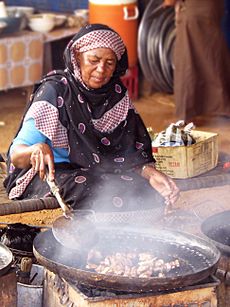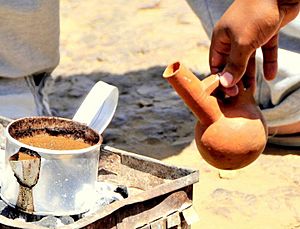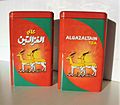Sudanese cuisine facts for kids
Sudanese cuisine is the delicious food from Sudan, a country in Africa. It has been shaped by many cultures over thousands of years. These include Arab, Nubian, Egyptian, Turkish, and Levantine influences. This mix of cultures makes Sudanese food unique and tasty!
Most meals in Sudan are shared with family, friends, and guests. This is a big part of Sudanese hospitality. The most common meats eaten are lamb and chicken. This follows the halal laws, which are rules for how food is prepared in the Muslim faith.
People in Sudan often eat different kinds of bread. These include aisha (or aish baladi) and kisra. Kisra is a thin bread, a bit like a pancake. These breads are usually eaten with savory stews called mullah. They also go well with cheese (jibna), fava beans, and tamiya (which is like falafel). Another fermented bread, gorrassa, is similar to Ethiopian injera but thinner.
Contents
Flavors from Around the World
Sudanese food has been influenced by many different countries. Let's look at some of them!
How Egyptian Food Influenced Sudan
Egyptian cuisine has had a big impact on Sudanese cooking. Both countries share many dishes. For example, tamiya (falafel) is popular in both. In Sudan, it's made with chickpeas, while in Egypt, it uses fava beans.
Another shared dish is ful medames. This is a national dish for both Sudan and Egypt. Molokhia, a thick soup made from boiled leaves, is also common. You might also find kamounia, a meat liver stew. For desserts, both countries enjoy umm ali and basbousa. A soft white cheese called jibna bayda is also eaten.
Turkish and Levantine Sweets
Turkish food has also given Sudanese cuisine a special touch. You can find dishes like kebabs, kofta (meatballs), and shawarma (sliced meat) in Sudan. Sweets like baklava also came from Turkish cooking. Many sweet treats from the Middle East, known as oriental or Levantine sweets, are popular in Sudan too.
Tasty Starters
Before the main meal, Sudanese people sometimes eat special appetizers. Two of these are elmaraara and umfitit. These dishes are made from parts of a sheep, like the lungs, liver, and stomach. They are mixed with onions, peanut butter, and salt. These dishes are often eaten raw. Another popular starter is a peanut salad called salatat dakaw.
Soups and Hearty Stews
Mullah is a savory stew that is very popular in Sudan. One common type is mullah ahmar, which is a red mincemeat sauce. It's often eaten with asida, a dish made from boiled wheat flour shaped into a ball. Asida is eaten in many parts of North Africa.
Some mullahs use a special sauce called waika, made from crushed okra. Another spice mix, niaimiya, gives some mullahs a sticky but flavorful texture. Dried waika can also be used as a seasoning. Most Sudanese mullahs include either meat, vegetables, or legumes (like beans or lentils).
Sometimes, seasoned meats are used. For example, Mullah sharmout is made with dried meats, onions, and dried okra. In rural Western Sudan, people use fermented foods like kawal instead of meat in their mullahs. Powdered kawal is also used like black pepper in cities.
Other stews include waika, bussaara, and sabaroag. These often use ni'aimiya (a Sudanese spice mix) and dried okra. Miris is a stew made from sheep's fat, onions, and dried okra. Abiyad is made from dried meat, while kajaik is made from dried fish. In the region of Equatoria (now in South Sudan), you might find kawari, a soup made from cattle or sheep hooves with vegetables. There's also elmussalammiya, made from liver, flour, dates, and spices.
Popular Drinks
The most popular drink in Sudan is water, either from the tap or bottled. Traditionally, large clay pots of water are offered for free on the streets for anyone who is thirsty.
Strong coffee is also very popular. It's sometimes served in special Sudanese coffee pots called jabana. Black tea, often with milk, is another favorite. You can often buy these drinks from "tea ladies" on the streets. On hot days, a traditional cold hibiscus tea called karkadeh is a refreshing drink made at home.
Images for kids
See also
 In Spanish: Gastronomía de Sudán para niños
In Spanish: Gastronomía de Sudán para niños







